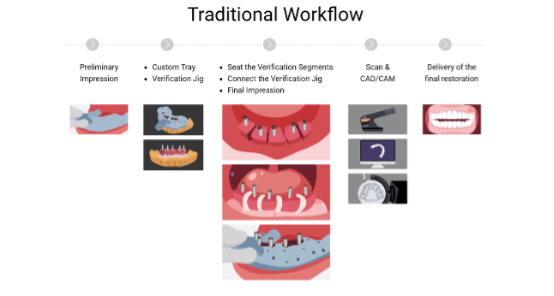Table of Contents
Digital dental solutions are driving dentistry towards greater precision and efficiency. Among these, dental intraoral scanners have replaced traditional impressions, bringing not only high accuracy, improved hygiene standards, and faster workflows but also enhanced patient experience, making them indispensable digital equipment in modern dental clinics.
To further improve precision in dental scanners, advanced technologies have been introduced. One of the most critical developments is intraoral photogrammetry (IPG). So, what is intraoral photogrammetry? And why does your clinic need IPG dental scanners? Here is a comprehensive guide.

What is Intraoral Photogrammetry (IPG)?
IPG is a digital measurement method that acquires 3D data of teeth and oral tissues through high-precision photogrammetric technology. It integrates advanced dental scan 3D image processing algorithms with real-time dynamic tracking technology, using coded patterns on scan bodies as precision control points. Even in full-mouth edentulous implant cases, it can achieve high precision.
Regular scan bodies typically require 360-degree scanning to capture positions based on surface geometric features. However, when scanning vibrating soft tissues between scan bodies, positioning accuracy can be significantly compromised. In contrast, IPG requires substantially fewer viewing angles to capture scan body positions, making the dental workflow considerably more efficient.
How Do IPG Dental Scanners Differ from Traditional Impressions?
The difference between IPG dental scanners and traditional impressions is particularly evident in workflow steps and time consumption. Photogrammetry dental scanners only require digital impressions, design and fabrication, and restoration delivery. In contrast, traditional impressions involve several steps, including preliminary impression, custom tray and verification jig fabrication, final impression, oral scan & CAD/CAM processing, and restoration delivery. It not only consumes more time and effort but also increases the likelihood of human errors.
Moreover, photogrammetry dental scanners can achieve micron-level precision, while traditional methods may have variations due to material and operational factors. For patients, the non-invasive 3D teeth scanning solution provides a more convenient and comfortable treatment experience.


Why Choose an IPG Dental Scanner?
In dental treatments, dentists face multiple challenges, including unstable soft tissue, poor scan body matching accuracy, insufficient scan body data details, and inaccuracies in full-arch scanning. These issues may lead to suboptimal treatment outcomes while increasing treatment time and costs.
The IPG dental scanners, as an advanced digital tool, effectively address these challenges by:
1. Exceptional Precision
The IPG dental scanners achieve scanning accuracy of up to 5μm, precisely capturing minute details of teeth and soft tissues. They can rapidly identify and calculate the position of scan bodies, enabling accurate planning of dental implant placement.
2. Simplified Workflow
The IPG dental scanner seamlessly integrates “IPG+scan” functions. It serves both as a standard dental intraoral scanner (IOS) for capturing detailed images of dentulous cases and as a photogrammetry system for all-on-X immediate loading cases, revolutionizing complex full-arch rehabilitations.
3. Improved Success Rate
The IPG dental scanners effectively address the challenge of tissue-implant alignment in blood- and saliva-rich environments through its Cap Scanbody. Both coded scanbody and Cap Scanbody data are converted into CAD data, significantly improving accuracy and success rates. This is particularly crucial for immediate loading procedures.
4. Enhanced Patient Experience
The fast and gag-free intraoral scanning process enhances patient comfort. The visualization of treatment plans also boosts trust and confidence.
5. Wide Application Scenarios
· Dentulous Implant Planning: Optimizes implant angles.
· Full-arch Edentulous Implants: Accurately scans edentulous arches, supporting all-on-X treatment plans.
· Crown Restoration: Provides data support for customized crown fabrication.
· Orthodontics: Evaluates tooth alignment and jaw relations to facilitate orthodontic treatment.
· Aesthetic Design: Simulates the smile curve to enhance the aesthetics of restorations.

SHINING 3D Dental’s Latest Intraoral Scanner – Aoralscan Elite Wireless
In digital dentistry, IPG intraoral scanners have redefined the standards of modern clinic competitiveness. Selecting a high-performance, user-friendly, and durable scanning device is crucial.
SHINING 3D Dental has developed the world’s first IPG wireless intraoral scanner—Aoralscan Elite Wireless. It is a groundbreaking 2-in-1 intraoral scanner (IOS) and photogrammetry system (IPG), suitable for common dental restorations and complex implant solutions.
Key features include:
· Weighing only 194g (including battery), it is currently the lightest wireless scanner for comfortable operation.
· Up to 5μm scanning accuracy with an enlarged IPG tip.
· Cap Scanbody ensures precise tissue-implant alignment, improving surgical success rates.
· Wi-Fi 6 technology enables ultra-fast and stable data transfer for smooth, efficient scanning.
· Long battery life with wireless charging support.

Final Words
Digital dentistry has brought numerous conveniences to the industry, particularly with the development of IPG intraoral scanners like the Aoralscan Elite Wireless, which has solved the challenges of soft tissue deformation and interference in edentulous implant cases.
SHINING 3D Dental remains committed to enhancing clinical efficiency and optimizing workflow for dental practices through high-precision digital technologies. Contact us now to elevate your clinical efficiency!
 ENG
ENG








